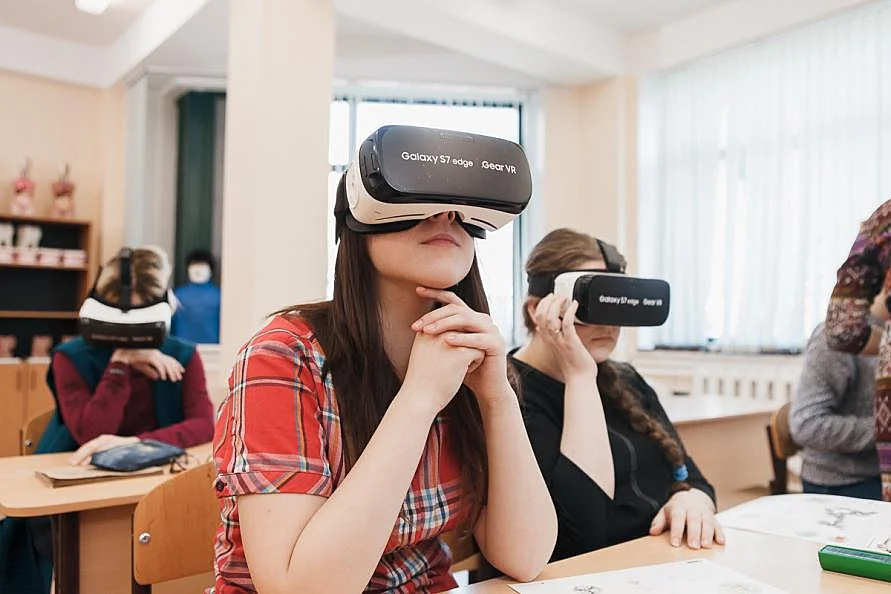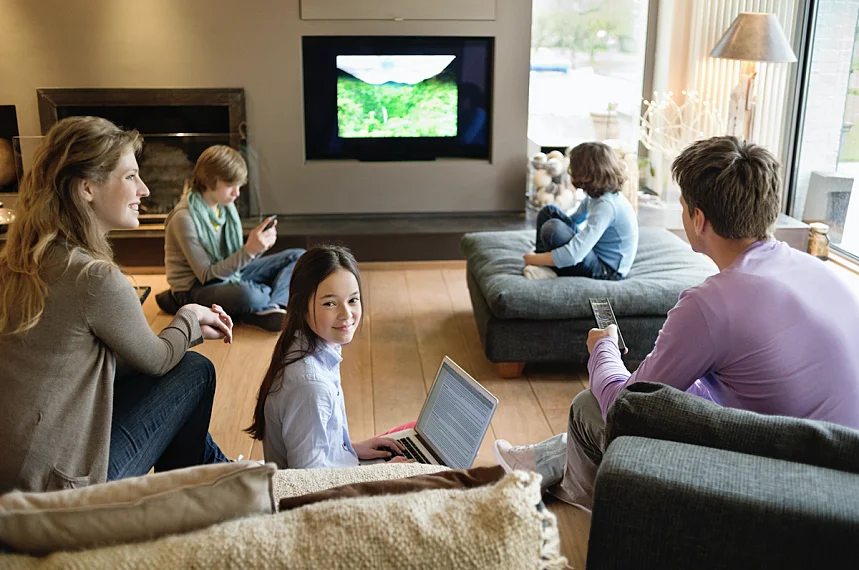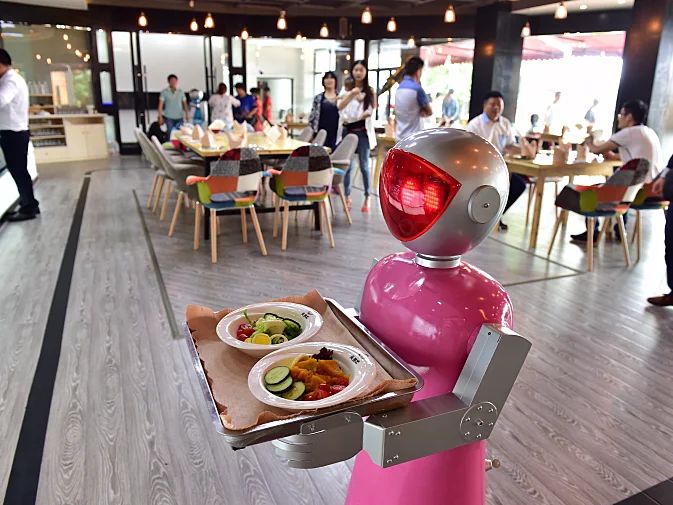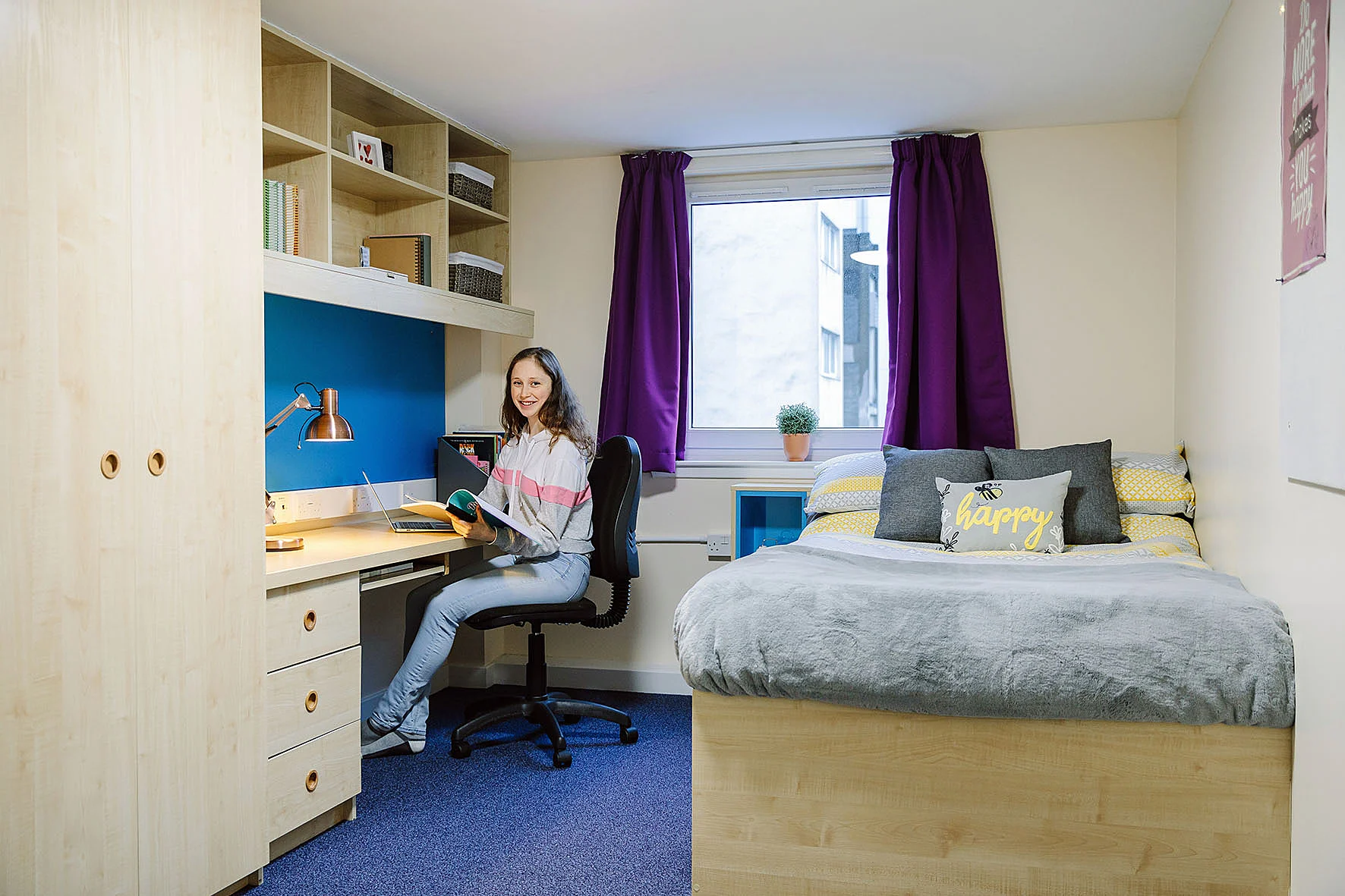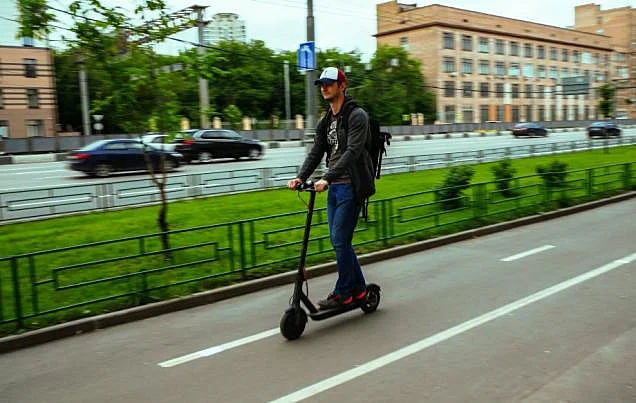4.1 Imagine that you and your friend are doing a school project «Home cinema experience». You have found some illustrations and want to share the news. Leave a voice message to your friend. In 2.5 minutes be ready to:
- explain the choice of the illustrations for the project by briefly describing them and noting the differences;
- mention the advantages (1–2) of watching films at home;
- mention the disadvantages (1–2) of watching films at home;
- express your opinion on the subject of the project – what film viewing preference you have and why.
You will speak for not more than 3 minutes (12–15 sentences). You have to talk continuously.
4.2 Imagine that you and your friend are doing a school project «Teenage fashion». You have found some illustrations and want to share the news. Leave a voice message to your friend. In 2.5 minutes be ready to:
- explain the choice of the illustrations for the project by briefly describing them and noting the differences;
- mention the advantages (1–2) of following teenage fashion trends;
- mention the disadvantages (1–2) of following teenage fashion trends;
- express your opinion on the subject of the project – what clothes are ideal for you and why.
You will speak for not more than 3 minutes (12–15 sentences). You have to talk continuously.
4.3 Imagine that you and your friend are doing a school project «Part-time jobs without a college degree». You have found some illustrations and want to share the news. Leave a voice message to your friend. In 2.5 minutes be ready to:
- explain the choice of the illustrations for the project by briefly describing them and noting the differences;
- mention the advantages (1–2) of the two types of jobs;
- mention the disadvantages (1–2) of the two types of jobs;
- express your opinion on the subject of the project – what part-time job would be ideal for you and why.
You will speak for not more than 3 minutes (12–15 sentences). You have to talk continuously.
4.4 Imagine that you and your friend are doing a school project «Modern classroom technologies». You have found some illustrations and want to share the news. Leave a voice message to your friend. In 2.5 minutes be ready to:
- explain the choice of the illustrations for the project by briefly describing them and noting the differences;
- mention the advantages (1–2) of modern technologies in education;
- mention the disadvantages (1–2) of modern technologies in education;
- express your opinion on the subject of the project – what modern technologies for engaging and interactive lessons you find effective and why.
You will speak for not more than 3 minutes (12–15 sentences). You have to talk continuously.
4.5 Imagine that you and your friend are doing a school project «Modern household conveniences». You have found some illustrations and want to share the news. Leave a voice message to your friend. In 2.5 minutes be ready to:
- explain the choice of the illustrations for the project by briefly describing them and noting the differences;
- mention the advantages (1–2) of using home tech products;
- mention the disadvantages (1–2) of using home tech products;
- express your opinion on the subject of the project – what smart home devices you cannot live without and why.
You will speak for not more than 3 minutes (12–15 sentences). You have to talk continuously.
4.6 Imagine that you and your friend are doing a school project «Family time ideas». You have found some illustrations and want to share the news. Leave a voice message to your friend. In 2.5 minutes be ready to:
- explain the choice of the illustrations for the project by briefly describing them and noting the differences;
- mention the advantages (1–2) of the two ways to spend time with family members;
- mention the disadvantages (1–2) of the two ways to spend time with family members;
- express your opinion on the subject of the project – what way to spend time with your family is ideal for you and why.
You will speak for not more than 3 minutes (12–15 sentences). You have to talk continuously.
4.7 Imagine that you and your friend are doing a school project «Homework habits». You have found some illustrations and want to share the news. Leave a voice message to your friend. In 2.5 minutes be ready to:
- explain the choice of the illustrations for the project by briefly describing them and noting the differences;
- mention the advantages (1–2) of the two homework habits;
- mention the disadvantages (1–2) of the two homework habits;
- express your opinion on the subject of the project – what homework habits you had as a child and why.
You will speak for not more than 3 minutes (12–15 sentences). You have to talk continuously.
4.8 Imagine that you and your friend are doing a school project «Housecleaning routine». You have found some illustrations and want to share the news. Leave a voice message to your friend. In 2.5 minutes be ready to:
- explain the choice of the illustrations for the project by briefly describing them and noting the differences;
- mention the advantages (1–2) of the two ways of having a clean home;
- mention the disadvantages (1–2) of the two ways of having a clean home;
- express your opinion on the subject of the project – which way of keeping your home clean you prefer and why.
You will speak for not more than 3 minutes (12–15 sentences). You have to talk continuously.
4.9 Imagine that you and your friend are doing a school project «Robots and jobs». You have found some illustrations and want to share the news. Leave a voice message to your friend. In 2.5 minutes be ready to:
- explain the choice of the illustrations for the project by briefly describing them and noting the differences;
- mention the advantages (1–2) of having robots in the workplace;
- mention the disadvantages (1–2) of having robots in the workplace;
- express your opinion on the subject of the project – what the future of work will look like in 10 years and why.
Ai-Da is the world’s first ultra-realistic robot artist.
You will speak for not more than 3 minutes (12–15 sentences). You have to talk continuously.
4.10 Imagine that you and your friend are doing a school project «Picnic spots». You have found some illustrations and want to share the news. Leave a voice message to your friend. In 2.5 minutes be ready to:
- explain the choice of the illustrations for the project by briefly describing them and noting the differences;
- mention the advantages (1–2) of the two picnic places;
- mention the disadvantages (1–2) of the two picnic places;
- express your opinion on the subject of the project – what picnic place is ideal for you and why.
You will speak for not more than 3 minutes (12–15 sentences). You have to talk continuously.
4.11 Imagine that you and your friend are doing a school project «Student accommodation solutions». You have found some illustrations and want to share the news. Leave a voice message to your friend. In 2.5 minutes be ready to:
- explain the choice of the illustrations for the project by briefly describing them and noting the differences;
- mention the advantages (1–2) of the two types of accommodation for students;
- mention the disadvantages (1–2) of the two types of accommodation for students;
- express your opinion on the subject of the project – which type of student accommodation would be ideal for you and why.
You will speak for not more than 3 minutes (12–15 sentences). You have to talk continuously.
4.12 Imagine that you and your friend are doing a school project «Commute choices». You have found some illustrations and want to share the news. Leave a voice message to your friend. In 2.5 minutes be ready to:
- explain the choice of the illustrations for the project by briefly describing them and noting the differences;
- mention the advantages (1–2) of the two ways to commute to work/ university;
- mention the disadvantages (1–2) of the two ways to commute to work/ university;
- express your opinion on the subject of the project – what way to commute would be ideal for you and why.
You will speak for not more than 3 minutes (12–15 sentences). You have to talk continuously.
Как выполнять задание 4 устной части в ЕГЭ-2023? Рекомендации М. В. Вербицкой
22 октября 2021 г. состоялась видеоконсультация по вопросам подготовки к ЕГЭ–2022 по иностранным языкам с участием Марии Вербицкой, руководителем комиссии по разработке КИМ ГИА по иностранным языкам. Ниже представлены основные тезисы из ее выступления, касаемые выполнения задания 4 устной части, монологического высказывания с элементами рассуждения: обоснования выбора фотографий-иллюстраций к предложенной проектной работе.

Задание 4 устной части из демонстрационной версии ЕГЭ–2023

Задание 4 устной части из демонстрационной версии ЕГЭ–2023
Изменилось условие задания
Теперь по условию задания вы вместе с другом выполняете школьный проект на какую-то конкретную тему (в демоверсии ЕГЭ–2023 приведена тема «Shopping»). Вы нашли фотографии по теме вашей проектной работы и хотите рассказать о них другу, записав голосовое сообщение.
В своем ответе вам необходимо:
– объяснить выбор иллюстраций для проекта, кратко описав их и отметив различия;
– указать преимущества (1–2) чего-то, что сравнивается в проектной работе (в демоверсии ЕГЭ–2023 в задании 4 сравниваются два вида совершения покупок: онлайн и офлайн, то есть необходимо указать преимущества двух данных видов покупок);
– указать недостатки (1–2) чего-то, что сравнивается в проектной работе;
То есть, к примеру, в задании 4 демоверсии ЕГЭ–2023 вам достаточно будет привести по одному достоинству и одному недостатку совершения покупок онлайн и по одному достоинству и одному недостатку совершения покупок офлайн (всего 4).
– Высказать мнение по теме проектной работы.
Вступление и заключение
Один из пунктов, по которому будет оцениваться ваш ответ (смотрите дополнительную схему оценивания ниже): «Наличие вступления с обращением к другу и заключения, завершённость высказывания.» Поэтому в начале и в конце высказывания добавьте по 1-2 фразы со вступлением и заключением.
Важна привязка к теме проекта
Теперь, выполняя данное задание, вам необходимо помнить, что вы не просто сравниваете две фотографии, а подбираете их к вашей проектной работе (по условию задания вы отправляете голосовое сообщение другу, который вместе с вами работает над проектом). Именно поэтому описание фотографий и перечисление их различий должно быть привязано к теме проектной работы.

Фотографии из задания 4 устной части демонстрационной версии ЕГЭ–2023

Фотографии из задания 4 устной части демонстрационной версии ЕГЭ–2023
К примеру, перечисляя различия фотографий из демоверсии ЕГЭ–2023, вам не нужно говорить: «На фотографии 1 изображено три человека, а на фотографии 2 один человек», так как это не относится к теме проектной работы «Shopping». Вам необходимо упомянуть, что семья на первой фотографии находится в магазине, в то время как на фотографии 2 девушка находится у себя дома. И, к примеру, что девушка на первой фотографии держит корзину с продуктами, в то время как девушка справа приобретает товары при помощи компьютера. Это различие также связано с темой проектной работы.
Дополнительная схема оценивания
Для подготовки к данному заданию рекомендуется обратить внимание не только на критерии оценивания, но и на дополнительную схему оценивания. Раньше подобная схема была только в руках экспертов. Она помогает им объективно оценить ответ участника экзамена. В этом году дополнительная схема оценивания опубликована в проекте демоверсии (актуальную демонстрационную версию вы можете скачать на сайте ФИПИ), чтобы участник экзамена мог сам себя проверить.
| 1. Решение коммуникативной задачи (Содержание) | ||||||||||
| Аспект 1. Объяснение выбора иллюстраций к проекту (краткое описание фотографий и указание на различия между ними) дано; связь фотографий с темой проекта выявлена. | ||||||||||
| Аспект 2. Достоинства (1–2) двух способов делать покупки названы | ||||||||||
| Аспект 3. Недостатки (1–2) двух способов делать покупки названы | ||||||||||
| Аспект 4. Мнение автора по теме проектной работы высказано – какой способ делать покупки он предпочитает и почему | ||||||||||
| ИТОГОВЫЙ БАЛЛ (максимальный балл – 4) | ||||||||||
| 2. Организация | ||||||||||
| Наличие вступления с обращением к другу и соответствующего заключения, завершённость высказывания | ||||||||||
| Логичность и использование средств логической связи | ||||||||||
| ИТОГОВЫЙ БАЛЛ (максимальный балл – 3) | ||||||||||
| ЯЗЫКОВОЕ ОФОРМЛЕНИЕ ВЫСКАЗЫВАНИЯ (максимальный балл – 3) |
Полный отрывок видеоконсультации с Марией Вербицкой по выполнению задания 4 устной части вы можете посмотреть ниже:
Источник: Федеральный институт педагогических измерений (ФИПИ)
Сообщить об ошибке в статье
Читайте также:
▫ Английские слова по теме «Астрономия, космос»
▫ Как писать электронное письмо в ЕГЭ–2023? Рекомендации М. В. Вербицкой
▫ Как выполнять задание 38 в ЕГЭ–2023? Рекомендации М. В. Вербицкой
Показать все статьи
Последнее задание в устной части ЕГЭ, или “обоснование выбора иллюстраций к проектной работе и выражение своего мнения по её проблематике” – еще один “лакомый” кусочек, потому что принесет ученику на экзамене 10 баллов при правильном выполнении. Читайте, как его сдать на максимум 👇🏻
Вот так оно выглядит на экзамене:
Легенда такая, что вы с другом делаете проект по одной из тем, которые обозначены в кодификаторе ЕГЭ, нашли две картинки для иллюстрации и рассказываете ему в голосовом сообщении, почему они такие классные и так пригодятся для вашего проекта.
Кстати, вот эти самые темы из кодификатора:
- Повседневный жизнь и быт, распределение домашних обязанностей в семье. Покупки
- Жизнь в городе и сельской местности. Проблемы села и города.
- Общение в семье и школе, семейные традиции, межличностные отношения с друзьями и знакомыми
- Здоровье и забота о нем, самочувствие, медицинские услуги. Здоровый образ жизни.
- Досуг молодёжи, посещение кружкой, спортивных секций, клубов по интересам. Переписка
- Путешествие по своей стране и за рубежом, осмотр достопримечательностей
- Природа и проблемы экологии
- Современный мир профессий, рынок труда
- Высшая школа и продолжение школьного образования
- Выбор профессии
- Роль иностранного языка в современном мире
- Школьное образование. Изучаемые предметы. Каникулы.
- Новые информационные технологии
- Праздники и знаменательные даты в различных странах
Если вас пугает этот список, то вы можете приобрести книгу по лексике, с которым вы подготовитесь к каждой из этих тем и будете знать, о чем говорить в этом задании и какие выражения для этого использовать.
Готовиться к заданию вы будете 2.5 минуты, а на само говорение отводится 3 минуты. Если вы закончили раньше, то все ок. Главное, чтобы осветила все пункты плана и не наделали ошибок.
Критерии оценивания
Как обычно, вначале посмотрим на критерии из официального документа:
А потом я вам им поясню:
Решение коммуникативной задачи (содержание)
Чтобы получить максимум за этот критерий, нужно:
- Сказать 12-15 фраз, то есть 3-4 фразы на каждый пункт плана. Если вы скажете больше, по делу, правильно и уложитесь во время ответа (3 минуты) – никто вас не накажет. Но если скажете меньше – то увы. 10-11 фраз принесут вам 2 балла по этому критерию, 8 – 9 – 1 балл, до 7 фраз – 0 баллов. А если получите 0 за этот критерий, то и 0 поставят за весь ответ.
- Ученик уложился во время
- Ученик раскрыл все 4 пункта плана:
Организация высказывания
Чтобы получить максимум за этот критерий, нужно:
- Не нарушить логику (то есть, переставлять пункты плана местами)
- Сделать вступление с обращением к другу и сказать заключительную фразу
- Использовать связки-переходы между пунктами плана
- Использовать средства логической связи и не допустить в них ошибки
Теперь дам примеры фраз, которые нужно вставлять в ответ:
Вступление
- Hi Yoda, how are you doing? I have sent you some pictures for our project “…” and I’d like to say a few words about them
- Hi Joker, I’ve found 2 photos for our project and I would like to tell you about them
Краткое описание и различия (1 пункт плана)
- Let me start with describing the pictures. In the first one there is/are … In the other picture you can see …
- Let me describe the pictures for you. The first photo shows … In the second photo one can see …
- I have chosen these pictures because they perfectly illustrate our project …
- These pictures are perfect for our project because they show/illustrate …
- Obviously, there are some differences between the pictures. In the 1st one …, but in the 2nd one …. Apart from that, in the first picture …, whereasin the other picture …
- These photos are quite different. There is/are … in the first picture, while there is/are … in the second one.
- As for the differences in the pictures, one can see that there is/are …
- Talking about the differences, the key difference is that in the 1st picture …, while in the 2nd picture ….
Достоинства (2 пункт плана)
- Now I will discuss the advantages of ….
- The great advantage of … is that …
- As for the advantages, … .
- Talking about …, its advantage is that … .
Недостатки (3 пункт плана)
- Now I will discuss the disadvantages of ….
- One of the key disadvantages of … is …
- As for the disadvantages, … .
- Talking about …, its drawback is that … .
Мнение (4 пункт плана)
- Personally, I … because …
- In my opinion, … The main reason for this is the fact that …
- As for me, I … because …
- In conclusion, I would like to say that I consider …
Заключение
- That’s all for now. Tell me your opinion about the pictures!
- That’s it. Please, tell me what you think about these photos.
- That’s all from me now, Please, get in touch with me and say what you think about the photos.
То есть, план ответа должен выглядеть вот так:
- introduction
- give a brief description of the photos (connected with the topic) + note the differences (2 черты – мой личный совет)
- mention the advantages (2 пункта – мой личный совет)
- mention the disadvantages (2 пункта – мой личный совет)
- express your opinion on the subject of the project – which … you prefer and why (тема написана в задании)
- conclusion
А ученикам предлагаю вот такой ☠️ “скелет” ☠️ высказывания:
- Hi Yoda, how are you doing? I have sent you some photos for our project “NAME” and I’d like to say a few words about them.
- Let me describe them for you. In the first picture one can see … . There is/are … in the second picture. Talking about the differences, the key difference is that in the 1st picture …, while in the 2nd picture ….
- I believe that … presented in the pictures have their advantages and disadvantages.
- As for the advantages of …, I would name ….
- Talking about the disadvantages of …
- Personally, I … The main reason for this is the fact that …
- That’s all from me now. Please, get in touch with me and tell me what you think about these photos.
Языковое оформление высказывания
Чтобы получить максимум за этот критерий, нужно:
- Допустить не больше 3-ех НЕгрубых лексико-грамматических ошибок или 3-ех НЕгрубых фонетческих ошибок
Чтобы понять, что за НЕгрубая ошибка такая, дадим определение обратному термину. Грубая ошибка – ошибка, искажающая понимание высказывания – отсутствие согласования подлежащего и сказуемого (they am/ he have), неправильная постановка артикля (in background/ we see a people), употребление Present Simple при описании картинки, ошибка в элементарной лексике (dress вместо wear, watch вместо look at, beer вместо bear), произношение слова thing /θɪŋ/ как /sɪŋ/. По-простому, это грамматика, лексика и произношение слов, которые все знают уже на уровне Pre-Intermediate.
Пример ответа
А теперь, используя мою схему, приведу образец ответа на это задание:
- Hi Yoda, how are you doing? I have sent you some photos for our project “Shopping” and I’d like to say a few words about them.
- Let me describe them for you. In the first picture one can see a happy family standing in the aisle of a supermarket. They’ve got a basket full of groceries in front of them. There is a woman sitting at home in front of her laptop in the second picture. She’s holding a credit card and smiling. Talking about the differences, the key difference is that in the 1st picture the family is shopping in a supermarket, while in the 2nd picture the woman is shopping online.
- I believe that the two types of shopping presented in the pictures have their advantages and disadvantages. As for offline shopping, its biggest advantage is that you can spend quality time with your family while going around the supermarket shopping for groceries. Talking about online shopping, one of its advantages is that you don’t have to carry heavy bags home as you can get your groceries delivered home.
- Now I will discuss the disadvantages of the two types of shopping. Offline shopping can be quite time-consuming as you have to spend time on the way to the shop and back home. While shopping online, if you are not careful enough your credit card details might be stolen and you can lose your money.
- Personally, I prefer online shopping because I hate going to regular shops. I dislike these crowds of people that fight for discounts and their place in the queues. When I shop online, there’s only me in the room so I do not suffer from any stress.
- That’s all from me now. Please, get intouch with me and tell me what you think about these photos.
(25 фраз)
У меня получилось прям высказывание высокого уровня. На экзамене вы можете говорить с использованием сложных грамматических структур и лексики, а можете – незаковыристо. Если соблюли все критерии и не сделали ошибок, ответ будет оценен на максимальный балл.
Основные ошибки
Теперь про основные “ляпы” учеников в этом задании.
В содержании:
- забывают вступление и заключение
- говорят не 2 черты отличий фото, и теряют по кол-ву фраз в ответе
- говорят мало фраз
- повторяют идеи в разных пунктах и грамматические структуры с лексикой
- забывают, что нужно назвать тему проекта, которая написана в задании (в нашем задании – “shopping”
- не используют подсказку из 2-го и 3-го пункта задания с advantages/disadvantages (в нашем примере – “the two types of shopping”)
- забывают, что в пункте 4 у нас уже написана проблема, по которой нужно высказать мнение, и придумывают свою и/или используют другую формулировку (например, в задании написано “prefer”, а говорят “would prefer”, например в нашем задании нужно сказать – “prefer offline/online shopping”)
- не укладываются во время и ученикам минусуют пункты, которые остались за пределами 3 минут высказывания
Последний пункт – прям типичное слабое место всех ЕГЭшников. Они очень долго не могут придумать, что сказать и как не повториться в идеях, и в итоге теряют время на записи ответа. Чтобы этого избежать, на первом этапе тренировки придерживаемся такого алгоритма подготовки: -> brainstorm карточки – прописываем ответ на это задание -> отчитываем -> заучиваем -> тренируемся с диктофоном. Если не получилось уложиться в 3 минуты, повторяем тренировку с диктофоном, пока не натренируем намертво.
Когда ученики запомнили схему ответа, уже ничего не записываем, тренируемся вживую на уроках. Если проблема повторяется, “долбим” проблемное задание, пока не получится уместить свой красивый ответ в эти ненавистные уже 3 минуты.
Некоторые репетиторы говорят, что начинают тренировать устную часть за 2 месяца до экзамена, чтобы не тратить на неё время в течение года. Я так не делаю, даже с учениками, с которыми занимаюсь больше, чем 9 месяцев до ЕГЭ. В моей практике надо хотя бы начинать её тренировать за полгода, пусть не очень усиленно, но нужно. Подкреплю примером. Недавно готовила к ЕГЭ девочку, с которой занималась 4-е года. В 2018 она сдала ОГЭ по английскому, потом экстернатом заканчивала 11 класс и сдавала ЕГЭ. Устную часть она не могла сделать мне на максимум около 3-ех месяцев.
В грамматике:
- Используют Present Simple при описании того, что видят на фотографии – The children hold presents
- Ставят неправильный предлог в словосочетании “in the picture/ photo” – there’s a family on/at the picture/ photo
- Забывают артикли – “there is boy in the photo” или ставят неправильные. Например, первый раз сказали про этого мальчика “a boy”, и продолжают про него говорить с неопределенным артиклем, хотя второй раз нужно говорить “the boy”
- Забывают окончание -s – “the photo show us children in the park”, или ставят его туда, где не нужно – “both pictures shows us …”
Нужно замечать, какие ошибки у ученика любимые и заставлять его контролировать себя. Можно задавать ему на дом сравнивать картинки, записывать себя на микрофон, слушать и отслеживать ошибки. Ну и вместе разбирать их на уроке.
На мой взгляд, задание совсем несложное, нужно просто выучить план ответа и хорошо его оттренировать.
Еще не забываем, что на экзамене вместе с учеником начнут сразу говорить еще несколько человек, которые сидят в компьютерном классе. Поэтому на занятиях полезно включать радио, или телевизор, когда ученик делает устную часть. Помогает справляться с звуковыми помехами на экзамене.
И еще
Пока не выпустили адекватных пособий для подготовки к этой части экзамена (кроме моей книги по устной части) И так как ФИПИ совсем недавно утвердило эту демоверсию, в интернете вы можете найти много неточной информации по этому заданию и фейков. Помните, самая точная информация – ТОЛЬКО НА ФИПИ.
Кстати, у эксперта на экзамене будет вот такая схема оценивания. Очень удобно!
Если вы этого еще не сделали – покупайте план ЕГЭ, который помог более 1.000 преподавателей по английскому подготовить своих учеников на высокие баллы
P.S. Про разделы и стратегии выполнения заданий ЕГЭ можно еще почитать:
Аудирование, задания 1 — 9
Чтение, задания 10 — 18
Грамматика, задания 19 — 25
Словообразование, задания 26 — 31
Лексика, задания 32 — 38
Личное письмо, задание 39
Проект, задание 40
Устная часть, задание 1
Устная часть, задание 2
Устная часть, задание 3
ELTgram от Ирины Кузнецовой
15 сентября 2022
В закладки
Обсудить
Жалоба
Шаблоны ЕГЭ 2023 — задания 38 письменной части и 4 устной части.
№38 → Письменное высказывание с элементами рассуждения на основе таблицы/диаграммы.
№4 → Связное тематическое монологическое высказывание с элементами рассуждения (обоснование выбора фотографий-иллюстраций к предложенной теме проектной работы и выражение собственного мнения по теме проекта).
sh38-4.pdf
Источник: vk.com/svetlana_english_online
В 2022 году выпускники, которые сдавали единый государственный экзамен по английскому языку, впервые выполняли задания устной части в новом формате. Перед ними стояла задача подготовить связное тематическое монологическое высказывание с элементами рассуждения.
Посмотрим на формулировку задания 4.
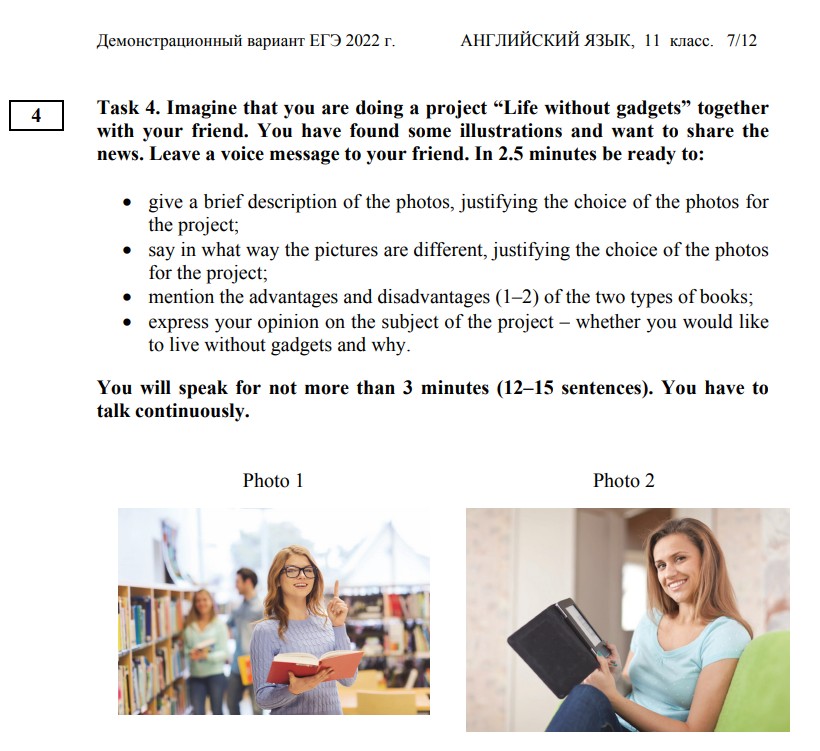
Это задание высокого уровня сложности, поэтому выпускникам важно уделять особое внимание этим двум моментам:
- обоснование выбора фотографий-иллюстраций к предложенной теме проектной работы,
- выражение собственного мнения по теме проекта.
Ответ оценивается по трем критериям:
- решение коммуникативной задачи/содержание (максимум — 4 балла),
- организация устного высказывания (максимум — 3 балла),
- языковое оформление высказывания (максимум — 3 балла).
Предлагаем также заглянуть в статьи:
Выделим несколько правил, которые помогут студентам выполнить задание 4 ЕГЭ 2022 на максимальный балл:
Правило 1
Пусть ученик представляет, что записываете голосовое сообщение своему реальному другу.
Сравните два вступления. Какое из них больше похоже на реальное голосовое сообщение?
Неформальный стиль, несложные предложения, чанки, характерные для устной речи на высоком уровне, полное и точное раскрытие темы — вот, чего ждут эксперты, приступая к оцениванию задания 4.
Проведите со студентом такой эксперимент. Попросите его представить, что он записывает голосовое сообщение другу, а затем спросите, сколько раз он заканчивал свое сообщение фразой «Это все, что я хотел(а) тебе сказать».
Результат наверняка будет близок к нулю. «Любимое» многими заключение That’s all I wanted to say, конечно, засчитают, но останется впечатление некачественно выполненной работы. Попросите ученика заменить заключение более естественной фразой, например, Let me know what you think. I’ll drop by tomorrow morning. See ya.
Правило 2
Попросите выделять ключевые слова в теме проекта. Например, в 2022 году одной из предложенных тем проекта в задании 4 была An unforgettable trip.
При описании фото многие участники экзамена приводили факты, связанные с темой trip, совершенно забывая, о том, что нужно выделить именно те моменты, которые делают эти поездки незабываемыми.
Сравните два ответа:
Правило 3
Предложите ученику сравнивать не картинки, а то, как деятельность, которая на них изображена, связана с предлагаемой темой проекта.
Задание 4 требует развитых когнитивных способностей, так как здесь оценивается не только умение описывать, но и умение рассуждать: сопоставлять и сравнивать, выделять главное и второстепенное, аргументировать точку зрения, находить причинно-следственные связи, делать выводы. Описание различий не должно быть автоматическим воспроизведением шаблона.
Приведем пример не совсем удачного ответа:
Согласитесь, наличие или отсутствие необходимого оборудования не является доказательством того, что поездка является незабываемой. То же правило действует и при определении преимуществ и недостатков.
Пусть студент сравнивает не картинки, а объекты, указанные в пункте 3 плана.
В 2022 году эксперты «смотрели широко» на этот аспект, учитывая новизну задания. Засчитывались следующие варианты ответа:
- преимущества двух объектов,
- недостатки двух объектов,
- преимущества и недостатки одного из объектов.
В 2023 году критерии оценивания могут несколько ужесточиться, поэтому ученикам важно уметь приводить преимущества и недостатки двух объектов. За всеми изменениями продолжайте следить на сайте ФИПИ.
Правило 5
Когда ученик говорит о предпочтениях, ему стоит использовать формулировку (глагольную форму) в точности так, как она представлена в пункте 4 плана. В плане могут использоваться формулировки, например, такие: you prefer, you’d prefer, you preferred as a child, would like.
Если участник экзамена использует в своем высказывании другую глагольную форму, это означает, что он не понимает коммуникативной задачи, и аспект считается нераскрытым.
Желаем успешной сдачи экзамена вашим ученикам!
Разбор устных заданий ЕГЭ 2023 по английскому языку на основании выступления Марии Валерьевны Вербицкой, руководителя комиссии по разработке КИМ. Рекомендации по выполнению заданий устной части на основании материалов ФИПИ. Кодификатор тем ФИПИ для эффективной подготовки к экзамену.
Задания устной части оцениваются в 20 баллов за весь раздел.
Задание 1. Чтение теста. Не очень дорогое, но и не сложное задание. Вы заработаете максимально 1 балл, если речь воспринимается легко: необоснованные паузы отсутствуют; фразовое ударение и интонационные контуры, произношение слов – без нарушений нормы; допускается не более 5 фонетических ошибок, в том числе 1–2 ошибки, искажающие смысл.
Задание 2. Условный диалог-расспрос (экзаменуемый задаёт вопросы). Необходимо задать 4 вопроса. За это задание можно получить 4 балла (по одному за каждый задаваемый вопросс). Вы получите балл за вопрос, если вопрос по содержанию отвечает поставленной задаче, имеет правильную грамматическую форму прямого вопроса; возможные фонетические и лексические погрешности не затрудняют восприятия.
!Важно помнить о построении прямого вопроса: вопросительное слово, вспомогательный глагол, подлежащее, сказуемое.
Задание 3. Условный диалог-расспрос (экзаменуемый отвечает на вопросы). Оценивается отдельно каждый ответ. Максимально 5 баллов. Балл за ответ начисляется, если дан полный и точный ответ на запрос информации: 2–3 коммуникативно обусловленные фразы, в которых отсутствуют элементарные лексикограмматические и/или фонетические ошибки.
! Нет необходимости наговаривать много предложений, экзаменатор не будет выбирать верные фразы, как это допускалось в прошлом году.
! 0 баллов вы получите, если ответ на вопрос не дан, ИЛИ содержание ответа не соответствует запросу информации, ИЛИ ответ содержит менее 2 фраз, ИЛИ в ответе имеются элементарные лексико-грамматические и/или фонетические ошибки (в том числе, когда ответ носит характер набора слов)
! Оценивается объем высказывания. Односложный ответ оценивается в 0 баллов.
Задание 4. Связное тематическое монологическое высказывание с элементами рассуждения (обоснование выбора фотографий-иллюстраций к предложенной теме проектной работы и выражение собственного мнения по теме проекта).
! Оценивается объем высказывания.
Максимальный балл -10 баллов.
Необходимо сделать обоснование выбора иллюстраций к проектной работе и выразить свое мнения по её проблематике.
!Обратите внимание — формат вашего высказывания, это голосовое сообщение другу.
-
Во-первых, нужно поздороваться, сообщить о цели звонка. (Привет, Алекс, я нашел 2 фото для нашего проекта. Мне кажется они очень подходят…(имя может быть любое))
-
Во-вторых, обосновать выбор фото, кратко отметив различия. Здесь важны только различия, относящиеся к теме проекта. (Если тема проекта чтение, то вы говорите, что на одном фото девушка читает книгу в библиотеке, а на втором электронную книгу у себя на диване. Здесь, к примеру, не важна внешность, одежда, цвет волос, но можно указать эмоции, или детали, которые раскроют тему проекта).
-
В третьих, укажите 1-2 преимущества, изображенного на каждой из фотографий. (В библиотеке особенная атмосфера, приятно читать бумажную книгу./Электронную книгу легко взять с собой или почитать дома, легко доступен большой выбор книг)
-
В четвертых, укажите 1-2 недостатка, изображенного на каждой из фотографий.
-
Наконец, выразите свое мнение, что вы скорее предпочтете и почему. (По моему мнению/ Мне кажется / Я считаю). Просите перезвонить вам. (Call me back, please). Прощаетесь.
Образец задания. Task 4. Imagine that you and your friend are doing a school project “Exercising”. You have found some illustrations and want to share the news. Leave a voice message to your friend. In 2.5 minutes be ready to: • explain the choice of the illustrations for the project by briefly describing them and noting the differences; • mention the advantages (1-2) of the two types of exercising; • mention the disadvantages (1–2) of the two types of exercising; • express your opinion on the subject of the project – which type of exercising you prefer and why. You will speak for not more than 3 minutes (12–15 sentences). You have to talk continuously.
Для эффективной подготовки к заданиям устной части рекомендуется посмотреть предметное содержание речи, в кодификаторе проверяемых требований к результатам освоения основной образовательной программы среднего общего образования и элементов содержания для проведения единого государственного экзамена по АНГЛИЙСКОМУ ЯЗЫКУ.
В кодификаторе указан список тем, которыми должен владеть экзаменуемый. Соотвественно, по этим темам и будут представлены задания.
Предметное содержание речи. (1 базовый 2 углубленный уровень)
-
A Повседневная жизнь и быт, распределение домашних обязанностей в семье. Покупки
-
Повседневная жизнь Домашние обязанности. Покупки. Общение в семье и в школе. Семейные традиции. Общение с друзьями и знакомыми. Переписка с друзьями
-
Повседневная жизнь Общество потребления. Самостоятельная жизнь. Отношения поколений в семье. Семейные истории. Круг друзей. Дружба и любовь
-
-
Б Жизнь в городе и сельской местности. Проблемы города и села
-
Городская и сельская жизнь Особенности городской и сельской жизни в России и странах изучаемого языка. Городская инфраструктура. Сельское хозяйство
-
Городская и сельская жизнь Развитие города и регионов
-
-
В Общение в семье и школе, семейные традиции, межличностные отношения с друзьями и знакомыми
-
Повседневная жизнь Домашние обязанности. Покупки. Общение в семье и в школе. Семейные традиции. Общение с друзьями и знакомыми. Переписка с друзьями
-
Повседневная жизнь Общество потребления. Самостоятельная жизнь. Отношения поколений в семье. Семейные истории. Круг друзей. Дружба и любовь
-
-
Г Здоровье и забота о нём, самочувствие, медицинские услуги. Здоровый образ жизни
-
Здоровье Посещение врача. Здоровый образ жизни
-
Здоровье Здоровый образ жизни и правильное питание. Современные тенденции в заботе о здоровье: йога, вегетарианство, фитнес
-
-
Д Роль молодёжи в современном обществе, её интересы и увлечения
-
Современная молодёжь Увлечения и интересы. Связь с предыдущими поколениями. Образовательные поездки
-
Современная молодёжь Молодёжные субкультуры. Молодёжные организации. Система ценностей. Волонтёрство
-
-
Е Досуг молодёжи: посещение кружков, спортивных секций, клубов по интересам. Переписка
-
Спорт Активный отдых. Экстремальные виды спорта
-
–
-
-
Ж Родная страна и страна/страны изучаемого языка. Их географическое положение, климат, население, города и сёла, достопримечательности
-
Страны изучаемого языка Географическое положение, климат, население, крупные города, достопримечательности. Путешествие по своей стране и за рубежом. Праздники и знаменательные даты в России и странах изучаемого языка.
-
Страны изучаемого языка Политические и экономические системы. Выдающиеся личности в истории стран изучаемого языка. Искусство.
-
-
З Путешествие по своей стране и за рубежом, осмотр достопримечательностей
-
Страны изучаемого языка Географическое положение, климат, население, крупные города, достопримечательности. Путешествие по своей стране и за рубежом. Праздники и знаменательные даты в России и странах изучаемого языка.
-
–
-
-
И Природа и проблемы экологии
-
Природа и экология Природные ресурсы. Возобновляемые источники энергии. Изменение климата и глобальное потепление. Знаменитые природные заповедники России и мира
-
Природа и экология Заповедники России. Энергосбережение. Последствия изменения климата. Деятельность различных организаций по защите окружающей среды. Экотуризм
-
-
К Культурно-исторические особенности своей страны и стран изучаемого языка
-
–
-
Культура и искусство Классическое и современное искусство. Изобразительные (живопись, архитектура, скульптура, графика) и неизобразительные (музыка, театр, кино, хореография) виды искусства. Мода и дизайн как часть культуры. Альтернативные виды искусства: граффити, декоративно-прикладное искусство. Интерактивные выставки и музеи. Произведения искусства и отношение к ним
-
-
Л Вклад России и стран изучаемого языка в развитие науки и мировой культуры
-
–
-
–
-
-
М Современный мир профессий, рынок труда
-
Профессии Современные профессии. Планы на будущее, проблемы выбора профессии. Образование и профессии
-
Современные профессии Профессии будущего. Карьера и семья. Успех в профессии О Планы на будущее, проблема выбора профессии
-
-
Н Возможности продолжения образования в высшей школе
-
Профессии Современные профессии. Планы на будущее, проблемы выбора профессии. Образование и профессии
-
Современные профессии Профессии будущего. Карьера и семья. Успех в профессии
-
-
О Планы на будущее, проблема выбора профессии
-
П Роль владения иностранными языками в современном мире
-
Иностранные языки Изучение иностранных языков. Иностранные языки в профессиональной деятельности и для повседневного общения. Выдающиеся личности, повлиявшие на развитие культуры и науки России и стран изучаемого языка
-
Иностранные языки Развитие языка. Диалекты. Молодёжный сленг. Профессиональный язык
-
-
Р Школьное образование. Изучаемые предметы, отношение к ним. Каникулы
-
–
-
–
-
-
С Научно-технический прогресс, его перспективы и последствия
-
Т Новые информационные технологии
-
Научно-технический прогресс Прогресс в науке. Космос. Новые информационные технологии
-
Научно-технический прогресс Дистанционное образование. Робототехника
-
-
У Праздники и знаменательные даты в различных странах мира
-
Страны изучаемого языка Географическое положение, климат, население, крупные города, достопримечательности. Путешествие по своей стране и за рубежом. Праздники и знаменательные даты в России и странах изучаемого языка.
-
–
-
ВАРИАНТ 1
Task 1. Imagine that you are preparing a project with your friend. You have found some interesting material for the presentation and you want to read this text to your friend. You have 1.5 minutes to read the text silently, then be ready to read it out aloud. You will not have more than 1.5 minutes to read it.
The first human carrying flight technology was the hot air balloon. While unmanned balloons have been around in some form for thousands of years, the first flight with people aboard was in 1782. The large balloon on top is called an “envelope”. It holds hot air created by a heat source known a burner. The burner creates an open flame by burning a mix of propane and air. Hot air balloons are capable of floating because the hot air inside the envelope has a lower density than the colder air outside. The top of the balloon usually has a vent which allows the pilot to control the speed of ascent or descent. Passengers typically stand in a basket beneath the envelope. While most envelopes have a standard balloon shape, others are designed to look like animals, cartoon characters and other fun objects.
Task 2. Study the advertisement. You are considering celebrating your birthday at a restaurant and now you’d like to get more information. In 1.5 minutes you are to ask four direct questions to find out about the following:

- location
- music choice
- price per person
- discounts for students

Task 3. You are going to give an interview. You have to answer five questions. Give full answers to the questions (2-3 sentences). Remember that you have 40 seconds to answer each question.
Tapescript for Task 3
Interviewer: Hello everybody! It’s Future Career Channel. Our guest today is a teenager from Russia and we are going to discuss his future career. We’d like to know our guest’s point of view on this issue. Please answer five questions. So, let’s get started.
Interviewer: What two school subjects are the most important for your future job?
Student: _________________________________________
Interviewer: What job would you like to have in the future?
Student: _________________________________________
Interviewer: Do your relatives approve of your career choice?
Student: __________________________________________
Interviewer: What job did you use to like when you were younger?
Student: __________________________________________
Interviewer: Would you like to follow in your parents’ footsteps in choosing a career? Why?
Student: __________________________________________
Interviewer: Thank you very much for the interview!
Task 4. Imagine that you are doing a project “Types of Shopping” together with your friend. You have found some illustrations and want to share the news. Leave a voice message to your friend. In 2.5 minutes be ready to tell the friend about the photos:
- explain the choice of the illustrations for the project by briefly describing them and noting the differences;
- mention the advantages (1-2) of the two types of shopping;
- mention the disadvantages (1-2) of the two types of shopping;
- express your opinion on the subject of the project – which type of shopping you would prefer and why.
You will speak for not more than 3 minutes (2-3 sentences for each item of the plan, 12–15 sentences total). You have to talk continuously.
Photo 1 Photo 2
ВАРИАНТ 2
Task 1. Imagine that you are preparing a project with your friend. You have found some interesting material for the presentation and you want to read this text to your friend. You have 1.5 minutes to read the text silently, then be ready to read it out aloud. You will not have more than 1.5 minutes to read it.
Many lands that had once been swamps were drained or filled in. There are different reasons why people drained swamplands. Some were drained to fight diseases caused by insects that lived in them. Because swamps were considered unpleasant places in which to live and harmful to health, many people thought that unless they were drained the land was worthless.
Other swamps were drained to make new land. As the population grew and more land was needed, people drained swamps or filled them to make room for more farms and factories, more roads and airports.
Few people thought that it might be harmful to get rid of swamps. As swamps disappeared, other things happened. There were both more floods and more droughts than before. There were also more fires, for swamps had acted as firebreaks. Hunters noticed that there was less wild game. Wild life that once lived in the swamps was dying out, because it had no place to live.
Task 2. Study the advertisement. You are going to visit a natural history museum and now you’d like to get more information. In 1.5 minutes you are to ask four direct questions to find out about the following:

- opening hours
- special exhibitions
- transport to the museum
- ticket price
Task 3. You are going to give an interview. You have to answer five questions. Give full answers to the questions (2-3 sentences). Remember that you have 40 seconds to answer each question.
Tapescript for Task 3
Interviewer: Hello everybody! It’s Holidays and Celebrations Channel. Our guest today is a teenager from Russia and we are going to discuss holidays and celebrations in Russia. We’d like to know our guest’s point of view on this issue. Please answer five questions. So, let’s get started.
Interviewer: What public holidays are celebrated in Russia?
Student: _______________________________________
Interviewer: What is your favourite public holiday? Why?
Student: _______________________________________
Interviewer: Do you like public celebrations? Why?
Student: _______________________________________
Interviewer: How did you celebrate last Christmas?
Student: _______________________________________
Interviewer: Where would you like to spend the best New Year holidays in your life? Why?
Student: _______________________________________
Interviewer: Thank you very much for the interview!
Task 4. Imagine that you are doing a project “Best Ways of Sightseeing” together with your friend. You have found some illustrations and want to share the news. Leave a voice message to your friend. In 2.5 minutes be ready to tell the friend about the photos:
- explain the choice of the illustrations for the project by briefly describing them and noting the differences;
- mention the advantages and disadvantages (1-2) of the two ways of sightseeing;
- mention the disadvantages (1-2) of the two ways of sightseeing;
- express your opinion on the subject of the project – which way of sightseeing you prefer and why.
You will speak for not more than 3 minutes (2-3 sentences for each item of the plan, 12–15 sentences total). You have to talk continuously.
Photo 1 Photo 2
ВАРИАНТ 3
Task 1. Imagine that you are preparing a project with your friend. You have found some interesting material for the presentation and you want to read this text to your friend. You have 1.5 minutes to read the text silently, then be ready to read it out aloud. You will not have more than 1.5 minutes to read it.
People have always told stories and legends to explain natural, but mysterious, occurrences such as the Northern Lights. The Vikings believed the Northern Lights were caused by the shining weapons of warriors. The Alaskan people thought the lights were the souls of salmon, deer and other animals. The Indians told the stories of giants living in the North and thought the lights were their torches.
The Northern Lights are actually caused by electrons from solar winds. They are attracted to the poles by the magnetic fields found there. They mix with gases in the atmosphere, which causes the gases to glow. The Northern Lights are most visible in the far north. They are typically green, purple, red or blue.
Task 2. Study the advertisement. You are considering renting a bike and now you’d like to get more information. In 1.5 minutes you are to ask four direct questions to find out about the following:

- location of rentals
- documents accepted
- price per hour
- opening hours
Task 3. You are going to give an interview. You have to answer five questions. Give full answers to the questions (2-3 sentences). Remember that you have 40 seconds to answer each question.
Tapescript for Task 3
Interviewer: Hello everybody! It’s School Channel. Our guest today is a teenager from Russia and we are going to discuss school uniform. We’d like to know our guest’s point of view on this issue. Please answer five questions. So, let’s get started.
Interviewer: Do you have to wear school uniform?
Student: ___________________________________________
Interviewer: Why is it important to wear school uniform? Why?
Student: ___________________________________________
Interviewer: What clothes do you usually wear to school?
Student: ___________________________________________
Interviewer: Did your parents use to wear school uniform in the past?
Student: ___________________________________________
Interviewer: Should all school students wear uniform in the future? Why?
Student: ___________________________________________
Interviewer: Thank you very much for the interview!
Task 4. Imagine that you are doing a project “Best Places to Live for a Teenager” together with your friend. You have found some illustrations and want to share the news. Leave a voice message to your friend. In 2.5 minutes be ready to tell the friend about the photos:
- explain the choice of the illustrations for the project by briefly describing them and noting the differences;
- mention the advantages (1-2) of the two places for living;
- mention the disadvantages (1-2) of the two places for living;
- express your opinion on the subject of the project – which place for living you would prefer and why.
You will speak for not more than 3 minutes (2-3 sentences for each item of the plan, 12–15 sentences total). You have to talk continuously.
Photo 1 Photo 2
ВАРИАНТ 4
Task 1. Imagine that you are preparing a project with your friend. You have found some interesting material for the presentation and you want to read this text to your friend. You have 1.5 minutes to read the text silently, then be ready to read it out aloud. You will not have more than 1.5 minutes to read it.
Japan is an island nation in East Asia, located in the North Pacific Ocean off the coast of the Asian continent. Japan comprises the four main islands in addition to numerous smaller islands. Tokyo is the country’s capital and largest city. Mountains dominate Japan’s landscape, covering 75 to 80 per cent of the country. Historically, the mountains were barriers to transportation, limiting the economic development of isolated areas. However, with the development of tunnels, bridges, and air transportation in the modern era, the mountains are no longer an obstacle. The Japanese have long celebrated the beauty of their mountains in art and literature, and today many mountain areas are preserved in national parks. Most of Japan’s people live on plains and lowlands found mainly along the lower courses of the country’s major rivers, on the lowest slopes of mountain ranges, and along the sea coast. This concentration of people makes Japan one of the world’s most crowded countries.
Task 2. Study the advertisement. You are considering buying a new smartphone and now you’d like to get more information. In 1.5 minutes you are to ask four direct questions to find out about the following:

- price
- battery life
- image and video quality
- number of cameras
Task 3. You are going to give an interview. You have to answer five questions. Give full answers to the questions (2-3 sentences). Remember that you have 40 seconds to answer each question.
Tapescript for Task 3
Interviewer: Hello everybody! It’s Languages Channel. Our guest today is a teenager from Russia and we are going to discuss foreign languages. We’d like to know our guest’s point of view on this issue. Please answer five questions. So, let’s get started.
Interviewer: Do you like studying foreign languages? Why?
Student: _____________________________________
Interviewer: Why is it important to speak a foreign language?
Student: _____________________________________
Interviewer: How can you improve your language skills?
Student: _____________________________________
Interviewer: Could you speak English when you were five?
Student: ______________________________________
Interviewer: What foreign language would you like to learn in the future? Why?
Student: ______________________________________
Interviewer: Thank you very much for the interview!
Task 4. Imagine that you are doing a project “Zoos” together with your friend. You have found some illustrations and want to share the news. Leave a voice message to your friend. In 2.5 minutes be ready to tell the friend about the photos:
- explain the choice of the illustrations for the project by briefly describing them and noting the differences;
- mention the advantages (1-2) of zoos;
- mention the disadvantages (1-2) of zoos;
- express your opinion on the subject of the project – should zoos exist in the future and why.
You will speak for not more than 3 minutes (2-3 sentences for each item of the plan, 12–15 sentences total). You have to talk continuously.
Photo 1 Photo 2
ВАРИАНТ 5
Task 1. Imagine that you are preparing a project with your friend. You have found some interesting material for the presentation and you want to read this text to your friend. You have 1.5 minutes to read the text silently, then be ready to read it out aloud. You will not have more than 1.5 minutes to read it.
Since ancient times, humans have loved and cherished cats as their pets. Today more than 80 million cats reside in US homes, with an estimated three cats for every dog on the planet. Yet there is still a lot we don’t know about our feline friends – including what they think of their owners. After observing pet cats for several years, scientists have come to an intriguing conclusion: cats don’t really understand people the way dogs do. They tend to feel it is they who own their masters, not vice versa. On the contrary, dogs perceive people as being very different from themselves. As soon as they see a human, they change their behaviour. The way a dog plays with a human is completely different from the way it plays with a dog. Cats are independent creatures and they can easily change their owner without changing their habits.
Task 2. Study the advertisement. You are considering going on a bus tour and now you’d like to get more information. In 1.5 minutes you are to ask four direct questions to find out about the following:

- price for a person
- audio guide in English
- starting point
- duration of the tour
Task 3. You are going to give an interview. You have to answer five questions. Give full answers to the questions (2-3 sentences). Remember that you have 40 seconds to answer each question.
Tapescript for Task 3
Interviewer: Hello everybody! It’s IT Channel. Our guest today is a teenager from Russia and we are going to discuss the Internet. We’d like to know our guest’s point of view on this issue. Please answer five questions. So, let’s get started.
Interviewer: How often do you use the Internet?
Student: _______________________________________
Interviewer: What do you usually use the Internet for?
Student: _______________________________________
Interviewer: Can the Internet be dangerous? Why?
Student: _______________________________________
Interviewer: Did you use the Internet for studying last year?
Student: ________________________________________
Interviewer: Would you like to study online instead of attending classes at school?
Student: ________________________________________
Interviewer: Thank you very much for the interview!
Task 4. Imagine that you are doing a project “Ways of Spending Leisure Time” together with your friend. You have found some illustrations and want to share the news. Leave a voice message to your friend. In 2.5 minutes be ready to tell the friend about the photos:
- explain the choice of the illustrations for the project by briefly describing them and noting the differences;
- mention the advantagesc(1-2) of the two ways of spending leisure time;
- mention the disadvantages (1-2) of the two ways of spending leisure time;
- express your opinion on the subject of the project – which way of spending your leisure time you would prefer and why.
You will speak for not more than 3 minutes (2-3 sentences for each item of the plan, 12–15 sentences total). You have to talk continuously.
Photo 1 Photo 2







